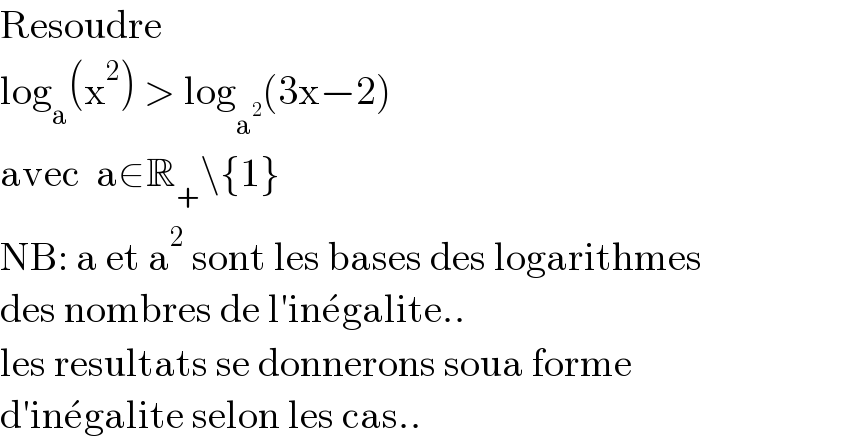Question Number 147714 by puissant last updated on 22/Jul/21

$$\mathrm{Resoudre} \\ $$$$\mathrm{log}_{\mathrm{a}} \left(\mathrm{x}^{\mathrm{2}} \right)\:>\:\mathrm{log}_{\mathrm{a}^{\mathrm{2}} } \left(\mathrm{3x}−\mathrm{2}\right) \\ $$$$\mathrm{avec}\:\:\mathrm{a}\in\mathbb{R}_{+} \backslash\left\{\mathrm{1}\right\} \\ $$$$\mathrm{NB}:\:\mathrm{a}\:\mathrm{et}\:\mathrm{a}^{\mathrm{2}} \:\mathrm{sont}\:\mathrm{les}\:\mathrm{bases}\:\mathrm{des}\:\mathrm{logarithmes} \\ $$$$\mathrm{des}\:\mathrm{nombres}\:\mathrm{de}\:\mathrm{l}'\mathrm{in}\acute {\mathrm{e}galite}.. \\ $$$$\mathrm{les}\:\mathrm{resultats}\:\mathrm{se}\:\mathrm{donnerons}\:\mathrm{soua}\:\mathrm{forme} \\ $$$$\mathrm{d}'\mathrm{in}\acute {\mathrm{e}galite}\:\mathrm{selon}\:\mathrm{les}\:\mathrm{cas}.. \\ $$
Answered by Olaf_Thorendsen last updated on 22/Jul/21
;α] : x−1 < 0 et x^3 +x^2 +x−2 ≤ 0 (2) est impossible. −Si x∈]α;1[ : x−1 < 0 et x^3 +x^2 +x−2 > 0 (2) est verifiee. −Si x∈[1;+∞[ : x−1 ≥ 0 et x^3 +x^2 +x−2 > 0 (2) est impossible. Finalement, S = ]α;1[ si a∈]0;1[ •2eme cas : a > 1, lna > 0 L′inegalite devient : (x−1)(x^3 +x^2 +x−2) > 0 (3) et S = ](2/3);α[∪]1;+∞[ si a∈]1;+∞[](https://www.tinkutara.com/question/Q147720.png)
$$\mathrm{log}_{{a}} \left({x}^{\mathrm{2}} \right)\:>\:\mathrm{log}_{{a}^{\mathrm{2}} } \left(\mathrm{3}{x}−\mathrm{2}\right),\:{a}\in\mathbb{R}_{+} ^{\ast} \backslash\left\{\mathrm{1}\right\} \\ $$$$\Leftrightarrow\:\frac{\mathrm{ln}\left({x}^{\mathrm{2}} \right)}{\mathrm{ln}{a}}\:>\:\frac{\mathrm{ln}\left(\mathrm{3}{x}−\mathrm{2}\right)}{\mathrm{ln}{a}^{\mathrm{2}} }\:=\:\frac{\mathrm{ln}\left(\mathrm{3}{x}−\mathrm{2}\right)}{\mathrm{2ln}{a}}\:\:\:\left(\mathrm{1}\right) \\ $$$$ \\ $$$$\bullet\mathrm{1er}\:\mathrm{cas}\::\:\mathrm{0}\:<\:{a}\:<\:\mathrm{1},\:\mathrm{ln}{a}\:<\:\mathrm{0} \\ $$$$\left(\mathrm{1}\right)\::\:\mathrm{ln}\left({x}^{\mathrm{2}} \right)\:<\:\frac{\mathrm{1}}{\mathrm{2}}\mathrm{ln}\left(\mathrm{3}{x}−\mathrm{2}\right) \\ $$$$\Leftrightarrow\:\mathrm{2ln}\left({x}^{\mathrm{2}} \right)\:<\:\mathrm{ln}\left(\mathrm{3}{x}−\mathrm{2}\right) \\ $$$$\Leftrightarrow\:\mathrm{ln}\left({x}^{\mathrm{4}} \right)\:<\:\mathrm{ln}\left(\mathrm{3}{x}−\mathrm{2}\right) \\ $$$$\Leftrightarrow\:{x}^{\mathrm{4}} \:<\:\mathrm{3}{x}−\mathrm{2} \\ $$$$\Leftrightarrow\:{x}^{\mathrm{4}} −\mathrm{3}{x}+\mathrm{2}\:<\:\mathrm{0} \\ $$$$\Leftrightarrow\:\left({x}−\mathrm{1}\right)\left({x}^{\mathrm{3}} +{x}^{\mathrm{2}} +{x}−\mathrm{2}\right)\:<\:\mathrm{0}\:\:\:\:\left(\mathrm{2}\right) \\ $$$$\mathrm{On}\:\mathrm{a}\:\mathrm{necessairement}\:\mathrm{3}{x}−\mathrm{2}\:>\:\mathrm{0} \\ $$$$\Rightarrow\:{x}\:>\:\frac{\mathrm{2}}{\mathrm{3}}\:\mathrm{et}\:\mathrm{l}'\mathrm{etude}\:\mathrm{du}\:\mathrm{trinome} \\ $$$$\:{x}^{\mathrm{3}} +{x}^{\mathrm{2}} +{x}−\mathrm{2}\:\mathrm{montre}\:\mathrm{qu}'\mathrm{il}\:\mathrm{admet}\:\mathrm{une} \\ $$$$\mathrm{racine}\:\mathrm{reelle}\:\mathrm{unique}\:\alpha\:\left(\approx\mathrm{0},\mathrm{811}\right) \\ $$$$ \\ $$$$\left.−\left.\mathrm{Si}\:{x}\in\right]\frac{\mathrm{2}}{\mathrm{3}};\alpha\right]\:: \\ $$$${x}−\mathrm{1}\:<\:\mathrm{0}\:\mathrm{et}\:{x}^{\mathrm{3}} +{x}^{\mathrm{2}} +{x}−\mathrm{2}\:\leqslant\:\mathrm{0} \\ $$$$\left(\mathrm{2}\right)\:\mathrm{est}\:\mathrm{impossible}. \\ $$$$ \\ $$$$\left.−\mathrm{Si}\:{x}\in\right]\alpha;\mathrm{1}\left[\::\right. \\ $$$${x}−\mathrm{1}\:<\:\mathrm{0}\:\mathrm{et}\:{x}^{\mathrm{3}} +{x}^{\mathrm{2}} +{x}−\mathrm{2}\:>\:\mathrm{0} \\ $$$$\left(\mathrm{2}\right)\:\mathrm{est}\:\mathrm{verifiee}. \\ $$$$ \\ $$$$−\mathrm{Si}\:{x}\in\left[\mathrm{1};+\infty\left[\::\right.\right. \\ $$$${x}−\mathrm{1}\:\geqslant\:\mathrm{0}\:\mathrm{et}\:{x}^{\mathrm{3}} +{x}^{\mathrm{2}} +{x}−\mathrm{2}\:>\:\mathrm{0} \\ $$$$\left(\mathrm{2}\right)\:\mathrm{est}\:\mathrm{impossible}. \\ $$$$ \\ $$$$\left.\mathrm{Finalement},\:\mathcal{S}\:=\:\right]\alpha;\mathrm{1}\left[\:\mathrm{si}\:{a}\in\right]\mathrm{0};\mathrm{1}\left[\right. \\ $$$$ \\ $$$$\bullet\mathrm{2eme}\:\mathrm{cas}\::\:{a}\:>\:\mathrm{1},\:\mathrm{ln}{a}\:>\:\mathrm{0} \\ $$$$\mathrm{L}'\mathrm{inegalite}\:\mathrm{devient}\:: \\ $$$$\left({x}−\mathrm{1}\right)\left({x}^{\mathrm{3}} +{x}^{\mathrm{2}} +{x}−\mathrm{2}\right)\:>\:\mathrm{0}\:\:\:\:\left(\mathrm{3}\right) \\ $$$$\left.\mathrm{et}\:\mathcal{S}\:=\:\right]\frac{\mathrm{2}}{\mathrm{3}};\alpha\left[\cup\right]\mathrm{1};+\infty\left[\:\mathrm{si}\:{a}\in\right]\mathrm{1};+\infty\left[\right. \\ $$
Commented by puissant last updated on 22/Jul/21

$$\mathrm{merci}\:\mathrm{prof} \\ $$
